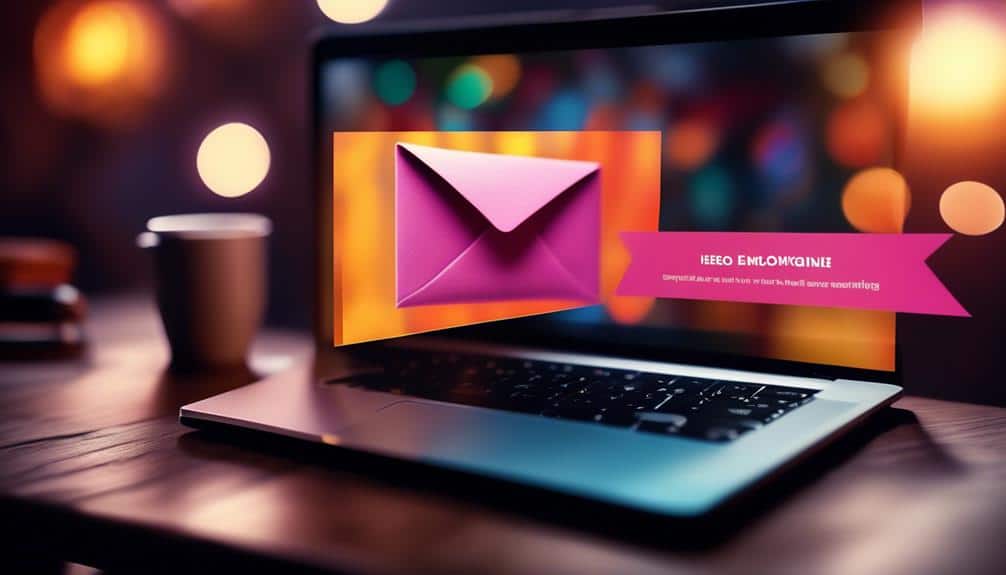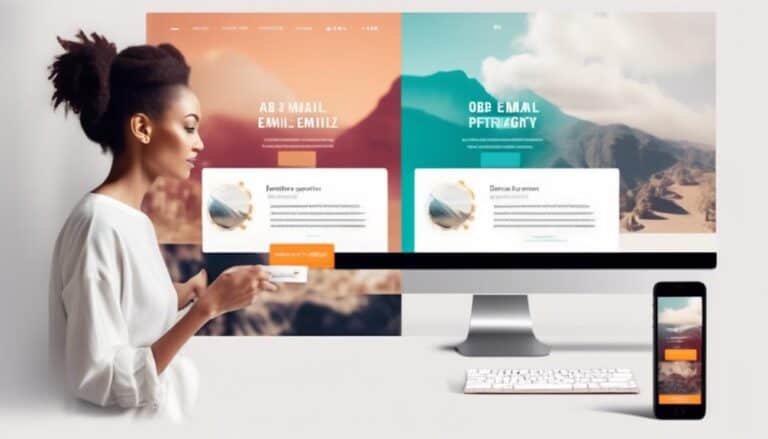Last Chance: Uncover the Email Marketing Tactics That Will Set You Apart
By pure coincidence, you stumbled upon this last chance to uncover the email marketing tactics that will set you apart from your competition. In a world where everyone's inbox is overflowing with emails, how do you ensure that yours stands out?
The answer lies in mastering the art of personalization, crafting attention-grabbing subject lines, targeting the right audience, streamlining your campaigns, enhancing your emails' visual appeal, and optimizing your strategy through testing and analytics.
But how exactly do you do all of this?
Stay tuned, because we're about to reveal the secrets that will take your email marketing to the next level.
Key Takeaways
- Personalization techniques are essential for effective email marketing, including addressing recipients by their first name and providing relevant and timely content.
- Crafting attention-grabbing subject lines is crucial to entice readers to open your email, using concise and clear language, creating a sense of urgency, and personalizing subject lines.
- Targeting the right audience through segmentation allows for more tailored and relevant content, using dynamic content and understanding preferences and behaviors to avoid sending irrelevant emails.
- Streamlining email campaigns with automation helps deliver personalized emails, schedule at optimal times, control frequency, and streamline workflow for more efficient email marketing.
Personalization: Tailoring Your Emails for Maximum Impact

Personalizing your emails is essential for maximizing their impact and increasing engagement with your audience. By incorporating customization techniques, you can add a personal touch to your emails that resonates with your readers. This not only captures their attention but also helps build a stronger connection with them.
One effective customization technique is to address your recipients by their first name. This simple gesture makes them feel acknowledged and valued, increasing the likelihood of them reading your email.
Additionally, segmenting your email list based on specific demographics or interests allows you to tailor your content to their preferences. This level of personalization shows that you understand their needs and are committed to delivering relevant information.
Another way to add a personal touch to your emails is by providing relevant and timely content. By understanding your audience's interests and pain points, you can deliver valuable information that addresses their specific needs. This not only demonstrates your expertise but also establishes trust and credibility with your readers.
Furthermore, consider using dynamic content in your emails. This allows you to display different content to different recipients based on their preferences or previous interactions with your brand. By showing that you remember and cater to their individual preferences, you create a personalized experience that encourages engagement.
Subject Lines: Crafting Attention-Grabbing Hooks
Craft attention-grabbing subject lines to increase open rates and capture your audience's interest from the moment they see your email. Crafting compelling subject lines is crucial to increasing open rates and getting your message across effectively. Here are three strategies to help you create attention-grabbing hooks that will resonate with your audience:
- Be concise and clear: Keep your subject lines short and to the point. Use language that's easy to understand and avoids ambiguity. This will make it easier for your audience to quickly grasp the value of your email and entice them to open it.
- Create a sense of urgency: Use words and phrases that create a sense of urgency, such as 'limited time offer' or 'exclusive deal.' This will encourage your audience to take immediate action and open your email to find out more.
- Personalize and segment: Tailor your subject lines to specific segments of your audience. Use their name or mention their interests to grab their attention. Personalization shows that you understand their needs and makes them more likely to open your email.
Segmentation: Targeting the Right Audience for Higher Engagement

To maximize your email marketing efforts and achieve higher engagement rates, it's essential to target the right audience through segmentation. List segmentation allows you to divide your subscribers into smaller groups based on specific criteria, such as demographics, interests, or past interactions. By sending tailored messages to each segment, you can deliver more relevant content that resonates with your audience.
One way to boost engagement is by using dynamic content. This feature enables you to personalize your emails to cater to the unique interests and preferences of each segment. By dynamically changing elements like images, offers, or calls to action, you can create a more personalized experience for your subscribers, increasing their likelihood of engaging with your emails.
Segmentation also helps you avoid sending irrelevant content to your subscribers. By understanding their preferences and behaviors, you can ensure that you only send them emails that are valuable and interesting to them. This not only improves engagement rates but also helps to build trust and loyalty with your audience.
Automation: Streamlining Your Email Campaigns for Efficiency
One way to streamline your email campaigns for maximum efficiency is by implementing automation. This powerful tool can help you optimize your email campaigns and save valuable time and resources.
Here are three key benefits of automation for email campaign optimization:
- Increased Personalization: Automation allows you to deliver personalized emails to your subscribers based on their preferences, behavior, and demographics. By segmenting your audience and creating targeted workflows, you can send relevant content that resonates with each individual subscriber. This level of personalization boosts engagement and conversion rates.
- Improved Timing and Frequency: With automation, you can schedule emails to be sent at the most optimal times, ensuring that your messages reach your audience when they're most likely to open and engage with them. Additionally, you can control the frequency of your emails, avoiding overwhelming your subscribers with too many messages or leaving them waiting for too long.
- Enhanced Workflow Efficiency: By automating repetitive tasks such as sending welcome emails, follow-ups, or abandoned cart reminders, you can free up your time and focus on other important aspects of your email marketing strategy. Automation streamlines your workflow, allowing you to manage and nurture your subscriber list more efficiently.
Implementing automation in your email campaigns can greatly enhance their performance and efficiency. By leveraging its benefits, you can deliver personalized content, optimize timing and frequency, and streamline your workflow, ultimately driving better results for your business.
Visual Design: Enhancing Your Emails for Visual Appeal

Now, let's shift our focus to the importance of visual design in enhancing the visual appeal of your emails, taking your email campaigns to the next level of engagement and impact.
Visual design plays a crucial role in capturing your audience's attention and conveying your message effectively. By understanding color psychology, you can strategically use colors to evoke emotions and create a memorable experience for your subscribers. For example, warm colors like red and orange can create a sense of urgency, while cool colors like blue and green can promote calmness and trust.
Additionally, incorporating responsive design ensures that your emails adapt seamlessly to different devices and screen sizes. This means that whether your subscribers are viewing your emails on a desktop computer or a mobile phone, they'll have a consistent and visually appealing experience. Responsive design not only improves the user experience but also boosts engagement and conversion rates.
Testing and Analytics: Optimizing Your Email Strategy for Success
Ready to take your email marketing strategy to the next level? A/B testing techniques allow you to experiment with different variables in your emails, such as subject lines or call-to-action buttons, to determine which ones yield the best results.
By relying on data-driven decision making, you can make informed choices about your email content and design, ultimately improving your open rates and click-through rates.
With the ability to track email performance, you can easily identify what works and what doesn't, allowing you to continuously optimize your email strategy for success.
A/B Testing Techniques
To maximize the effectiveness of your email marketing strategy, employing A/B testing techniques is crucial. A/B testing allows you to compare different variations of your emails and measure their effectiveness, helping you make data-driven decisions to optimize your campaigns.
Here are three A/B testing best practices to consider:
- Test a single variable: To accurately measure the impact of a specific change, such as subject line or call-to-action, it's important to test only one variable at a time. This allows you to isolate the effect of that particular element and make informed decisions.
- Segment your audience: Different segments of your audience may respond differently to various elements in your emails. By segmenting your audience and conducting A/B tests on each segment, you can personalize your emails and tailor them to specific preferences.
- Set clear goals and metrics: Before conducting any A/B test, define clear goals and metrics to measure success. Whether it's open rates, click-through rates, or conversions, having specific metrics will help you analyze the results and determine which variation performed better.
Data-Driven Decision Making
After successfully implementing A/B testing techniques to optimize your email marketing campaigns, the next step is to leverage data-driven decision making through testing and analytics in order to further optimize your email strategy for success.
Data-driven decision making involves analyzing the results of your email performance analysis and using that data to make informed decisions about your future campaigns.
By examining key metrics such as open rates, click-through rates, and conversion rates, you can identify trends and patterns that will help you understand what works and what doesn't.
This will enable you to refine your email content, design, and targeting to better serve your audience and achieve your goals.
Tracking Email Performance
Have you ever wondered how to track the performance of your email marketing campaigns and optimize your strategy for success? Tracking email performance is crucial in understanding the effectiveness of your campaigns and making data-driven decisions to improve your results.
Here are three key steps to help you measure and evaluate your email campaign success:
- Analyze Open Rates and Click Through Rates: These metrics provide insights into how many recipients opened your emails and clicked on the links within them. By monitoring these rates, you can gauge the level of engagement and interest among your audience.
- Utilize Email Analytics Tools: There are various tools available that can provide detailed reports on your email performance. These tools can track metrics like delivery rates, bounce rates, unsubscribe rates, and more, giving you valuable data to evaluate and optimize your campaigns.
- Optimize Email Content: Analyzing the performance of your emails allows you to identify areas for improvement. By testing different subject lines, call-to-action buttons, and email designs, you can tailor your content to increase engagement and drive better results.
Tracking email performance and using email analytics tools are essential in improving email engagement and optimizing your email content. By analyzing open rates and click-through rates, measuring email campaign success becomes more achievable.
Frequently Asked Questions
How Can I Personalize My Emails Without Coming Across as Invasive or Creepy?
Personalize your emails without being invasive or creepy by striking the right balance. Show genuine interest in your customers, use their names, and tailor content based on their preferences. Maintain engagement without crossing boundaries.
What Are Some Effective Subject Line Strategies for Different Types of Email Campaigns?
To optimize your email subject lines, try different strategies for different campaigns. Use A/B testing to see what resonates with your audience. Engage them with concise and persuasive language that serves their needs.
How Do I Determine the Right Audience Segments for My Email Campaigns?
To determine the right audience segments for your email campaigns, start by analyzing your customer data. Use targeting strategies like demographics, purchase history, and behavior to create personalized messages that resonate with each segment.
What Are Some Best Practices for Automating Email Campaigns to Ensure Efficiency?
To ensure efficiency and engagement in your email campaigns, automate them. Use tools that allow you to schedule emails, segment your audience, and personalize content. This way, you can save time and deliver targeted messages that resonate with your subscribers.
How Can I Make My Emails Visually Appealing Without Sacrificing the Overall Message and Readability?
To make your emails visually appealing without sacrificing the message and readability, use eye-catching images, clean and organized layouts, and complementary colors. Don't forget to include a clear call-to-action to drive engagement.
Conclusion
Don't miss out on the opportunity to elevate your email marketing game. By personalizing your emails, crafting attention-grabbing subject lines, targeting the right audience, automating your campaigns, enhancing visual appeal, and optimizing through testing and analytics, you can set yourself apart from the competition.
Take the last chance to uncover these tactics and watch your email strategy thrive.








